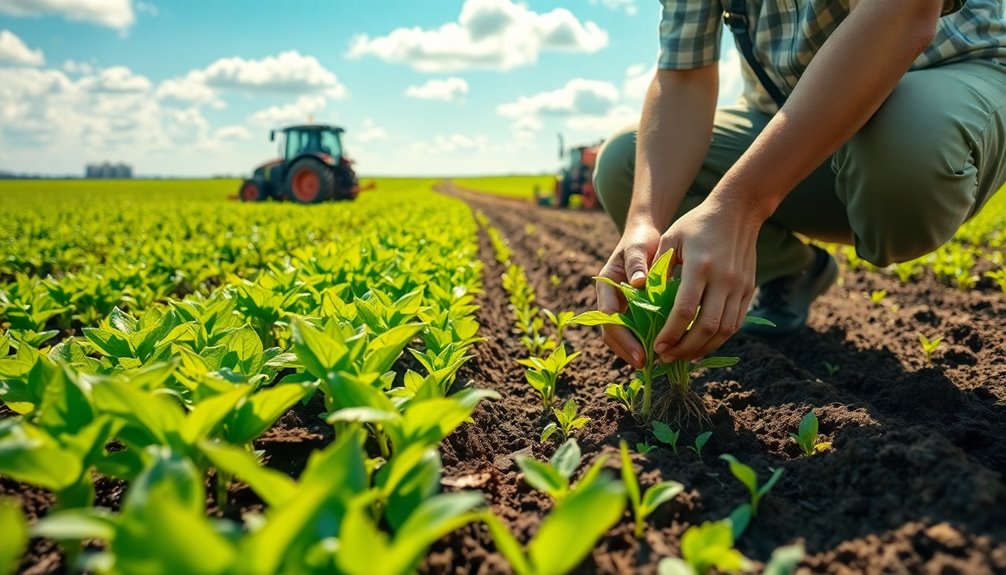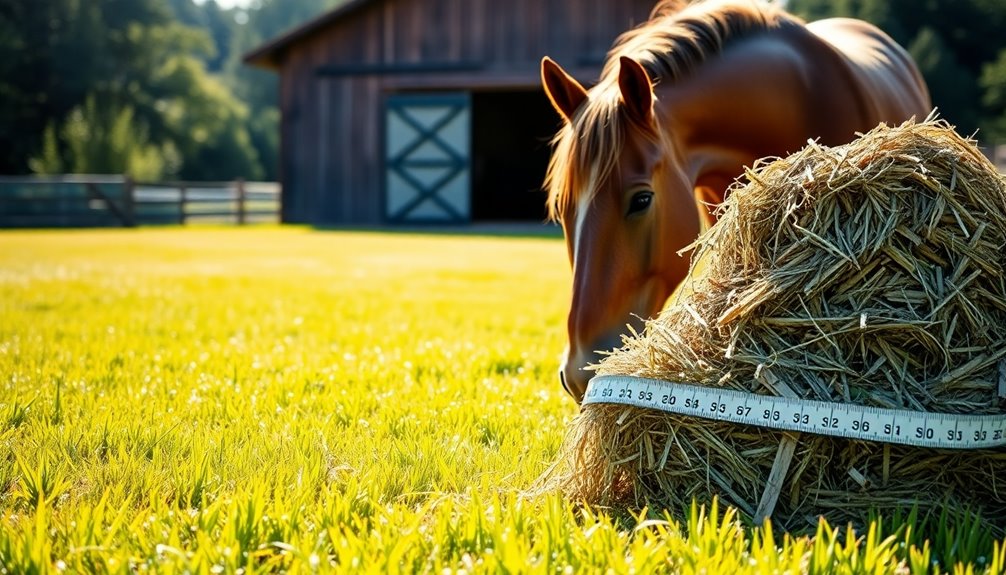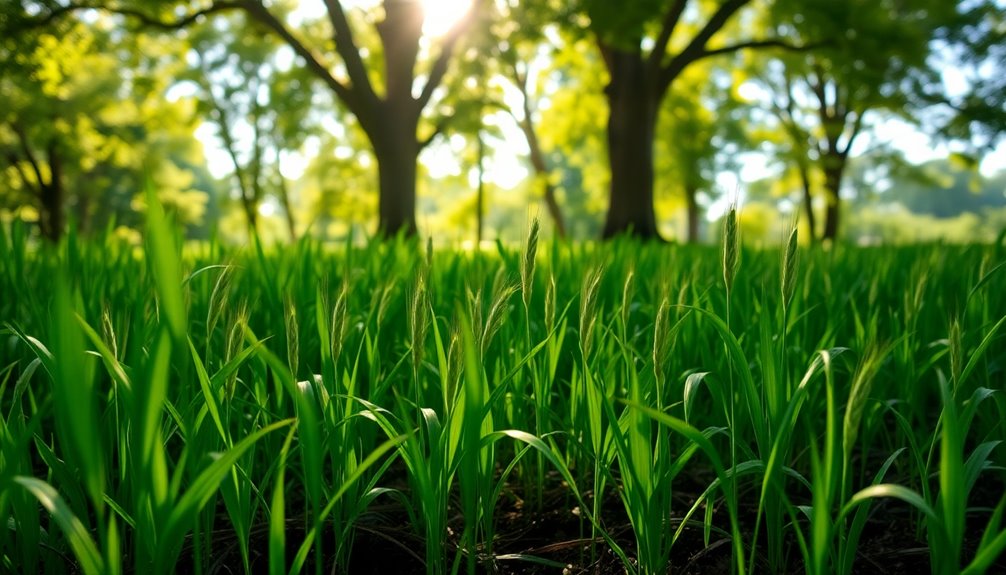Establishing forage crops starts with careful planning. You'll want to conduct soil tests to check nutrient levels and pH, targeting a balance between 6.0 and 7.0. Timing is vital; late summer seeding in Pennsylvania's ideal. Use effective weed control to minimize competition and guarantee seeds have proper contact with soil. Incorporating organic matter can enhance soil health, while choosing pest-resistant species can boost resilience. Monitor moisture and fertility throughout growth for best results. By mastering these essentials, you'll set the stage for a thriving forage crop. Keep going, and you'll uncover even more strategies to maximize your yields!
Key Takeaways
- Conduct soil testing to determine nutrient levels and pH, ensuring optimal conditions for forage crop establishment.
- Select suitable forage species based on soil health and nutrient deficiencies identified during testing.
- Implement effective weed control strategies before and after planting to minimize competition for resources.
- Use no-till seeding methods to enhance soil structure and moisture retention, promoting better seed-to-soil contact.
- Regularly monitor and manage soil moisture and pests to support healthy forage growth and maximize yields.
Planning and Preparation
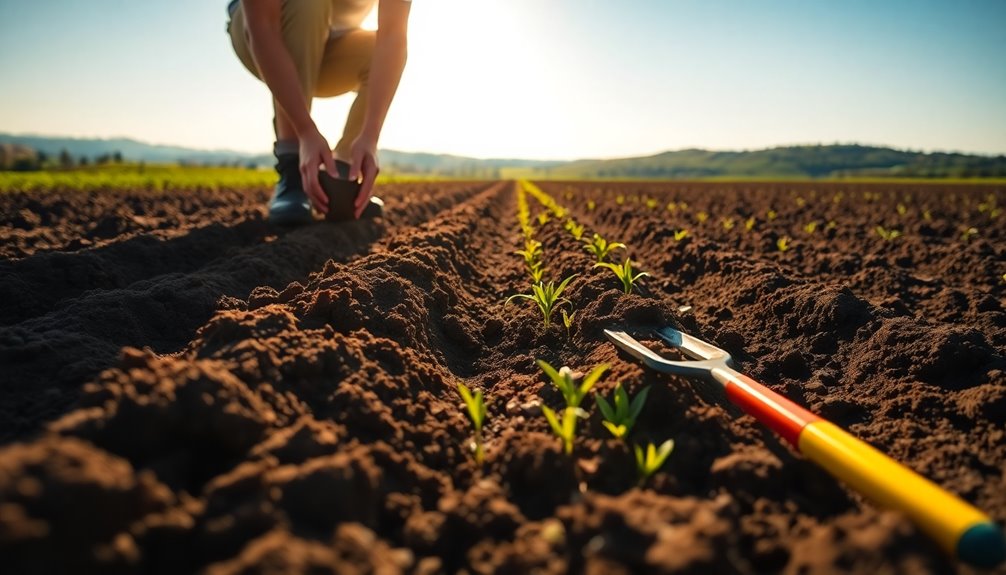
Planning and preparation for successful forage crop establishment should ideally start at least 18 months before you even think about seeding.
Begin by conducting soil testing to assess nutrient levels and soil pH. This will help you identify any deficiencies that need addressing, as well as inform your choices for forage species that will thrive in your specific soil type. Regular tests every 3-4 years will guarantee your nutrient management remains accurate.
Next, focus on effective weed control strategies. You'll need to monitor herbicide use carefully, especially with products like triazines, which can harm legume seedlings if applied too late.
It's also wise to rotate out legumes like alfalfa for at least one year to reduce pest and disease risks.
If your soil pH is low, apply lime at least six months before seeding. This correction is essential for enhancing nutrient availability and encouraging microbial activity in the soil.
Timing for Seed Selection
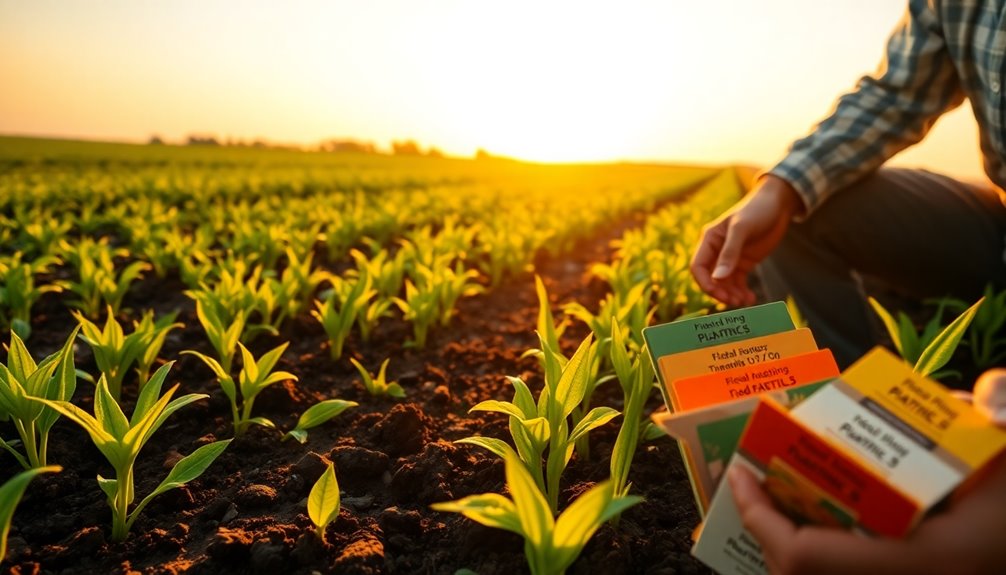
Choosing the right time for seeding your forage crops can make all the difference in their establishment success. In Pennsylvania, late summer is often the best timing for planting forage seeds. This period provides favorable conditions that promote growth and robust establishment.
Early ordering of forage seed varieties is crucial to secure the best options, especially since some species might've limited availability during peak planting seasons.
While spring seedings are possible, they come with challenges, such as wet soil conditions and increased weed competition, which can hinder successful forage establishment. To enhance your efforts, pay attention to soil types and confirm you're selecting seeds suited for your specific conditions.
When it comes to seeding rates, consistency is key. You want to avoid planting too deep—ideally, your seeds should be no more than 3/8 inches deep to guarantee proper germination rates.
Adequate seed-to-soil contact is essential for moisture absorption, so focus on timely and well-prepared seedbed preparation. By being mindful of these factors, you'll set yourself up for a thriving forage crop that meets your farming goals.
Tillage and Soil Management
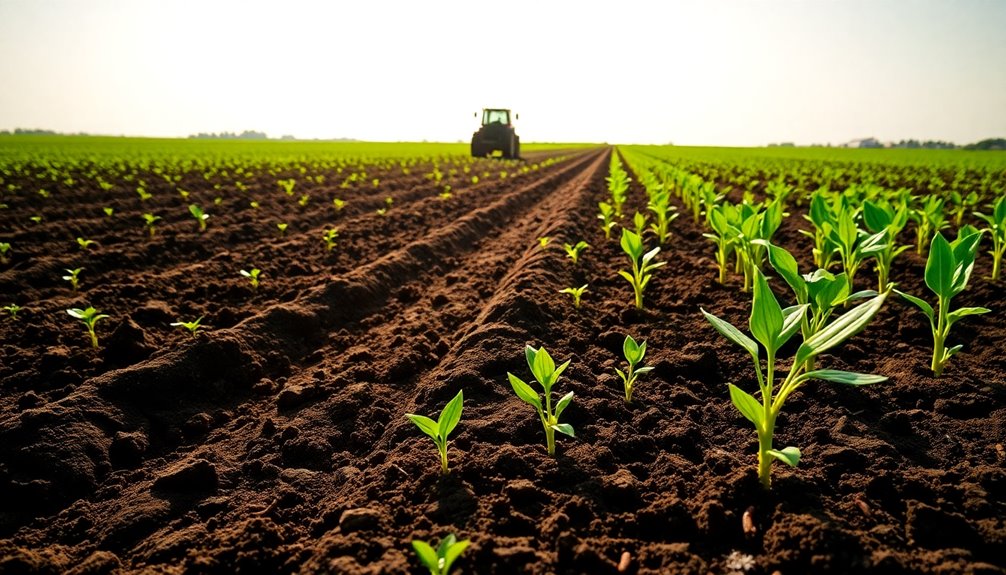
When you're establishing forage crops, consider the benefits of no-till seeding, especially in challenging terrains.
Preparing a firm, fine seedbed is essential, as it enhances seed-to-soil contact and promotes better moisture absorption.
No-Till Seeding Benefits
No-till seeding offers significant advantages for establishing forage crops, especially in challenging environments.
By minimizing soil disturbance, this method preserves soil structure and enhances moisture retention, both essential for successful forage establishment.
It's particularly beneficial in rocky or erosion-prone fields where conventional tillage can worsen soil erosion and compaction issues.
Here are some key benefits of no-till seeding:
- Preserves soil structure, promoting better water movement
- Prevents compaction that hinders root development
- Enhances soil health by boosting microbial activity
- Increases organic matter retention for improved nutrient cycling
- Effectively controls perennial weeds prior to seeding
Soil Bed Preparation
Effective soil bed preparation is essential for establishing healthy forage crops. Start by evaluating your soil's condition and avoid conventional tillage in rocky or erosion-prone fields. Instead, consider no-till seeding as a reliable practice for effective soil management and forage establishment.
Timing is critical—tilling wet soils can lead to compaction, hindering root development and water movement. Aim to create a firm, fine seedbed to enhance seed-to-soil contact. This is important for moisture absorption, which directly impacts the growth of your forage crops.
Additionally, level seedbeds not only reduce equipment stress during planting but also promote uniform growth, improving the longevity of your forage stands.
Before you seed, take the final opportunity to manage perennial weeds effectively. Investing time in weed management at this stage can greatly enhance your establishment success.
Fertilization and Soil Health
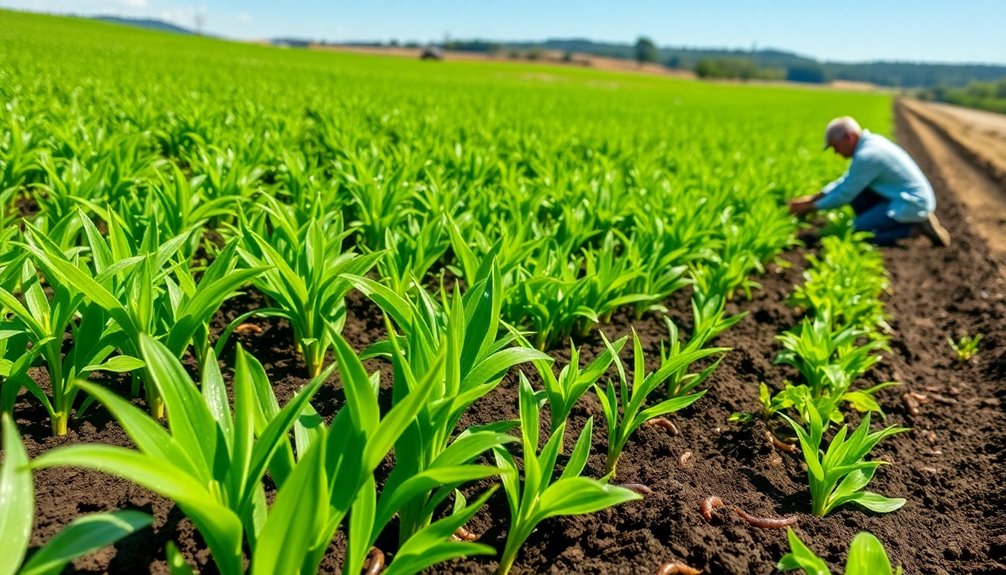
Maintaining proper soil health is vital for establishing robust forage crops, and it starts with achieving the right pH levels. Aim for a pH between 6.0 and 7.0, adjusting with lime based on your soil tests. This balance enhances nutrient availability and boosts microbial activity, which are fundamental for healthy growth.
To effectively manage fertilization and soil health, keep these key points in mind:
- Regularly conduct soil tests to identify nutrient needs.
- Monitor nitrogen levels, avoiding excessive applications in late fall.
- Incorporate organic matter to improve soil structure and fertility.
- Implement minimal tillage practices for better moisture retention.
- Guarantee a balance of nitrogen, phosphorus, potassium, and sulfur for ideal forage establishment.
Weed Control Strategies
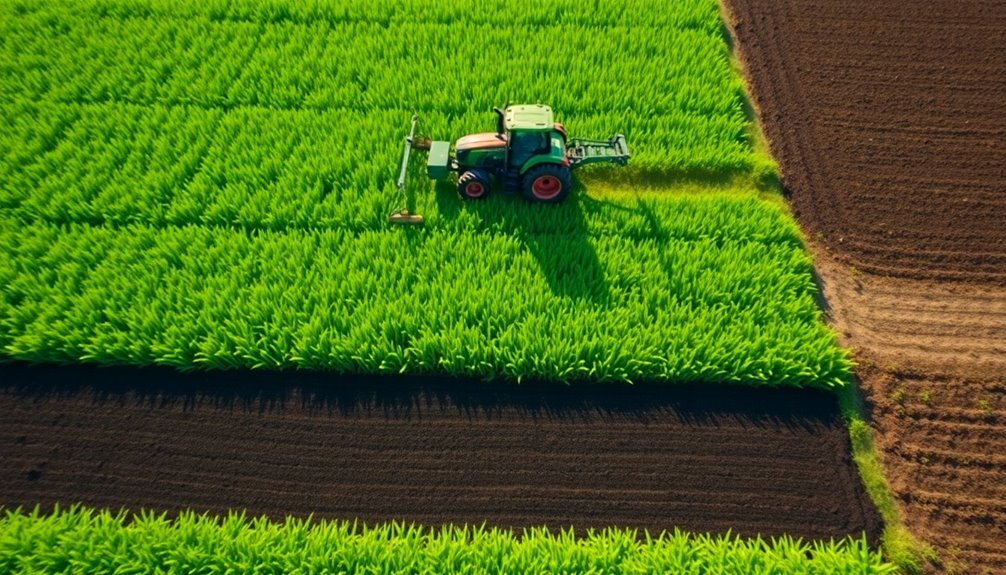
When establishing forage crops, effective weed control before planting is key to your success.
You'll want to guarantee you apply herbicides at the right time and keep an eye on weed populations throughout the growing season.
Pre-Planting Weed Control
Successful weed control before planting is essential for establishing healthy forage crops. By implementing effective pre-planting weed control strategies, you can minimize competition for resources, leading to improved seedling vigor and long-term productivity.
Here are some key practices to evaluate:
- Conduct regular soil testing to assess nutrient levels.
- Use proper timing for planting to disrupt weed growth cycles.
- Rotate crops to reduce weed populations naturally.
- Apply starter fertilizers to enhance the competitiveness of your forage crops.
- Incorporate companion crops during the establishment year to suppress weeds while providing additional feed.
Herbicide Application Timing
Timing herbicide applications is essential for effective weed control and the successful establishment of forage crops. Proper herbicide application timing helps you minimize competition from weeds, ensuring your forage seedlings can thrive. If you apply triazine herbicides too late, you risk harming legume seedlings, which can hinder their establishment and vigor.
To optimize your weed control strategies, plan your herbicide applications according to soil conditions and weather forecasts. Monitoring weed populations regularly is key; this allows you to make timely applications that prevent weeds from outcompeting your young forage crops during critical early growth stages.
Following recommended guidelines for herbicide application timing can greatly improve your success rate in forage establishment. By reducing weed pressure, you'll promote healthy seedling growth and create a robust forage system.
Monitoring Post-Establishment Weeds
Monitoring post-establishment weeds is essential for maintaining the health and productivity of your forage crops. Regularly keeping an eye on weed populations allows you to take timely action, preventing these unwanted plants from competing with your young seedlings.
Effective weed control strategies during this phase can greatly enhance the vigor of your forage crops.
Here are some key practices to take into account:
- Pre-seeding weed management to reduce competition for resources.
- Regular monitoring to catch weeds early before they establish.
- Cultural practices like proper seeding depth and timing to minimize pressure.
- Appropriate herbicide application, taking care to protect young seedlings.
- Implementing a "take half, leave half" grazing strategy to manage weed growth.
Pest Management Techniques
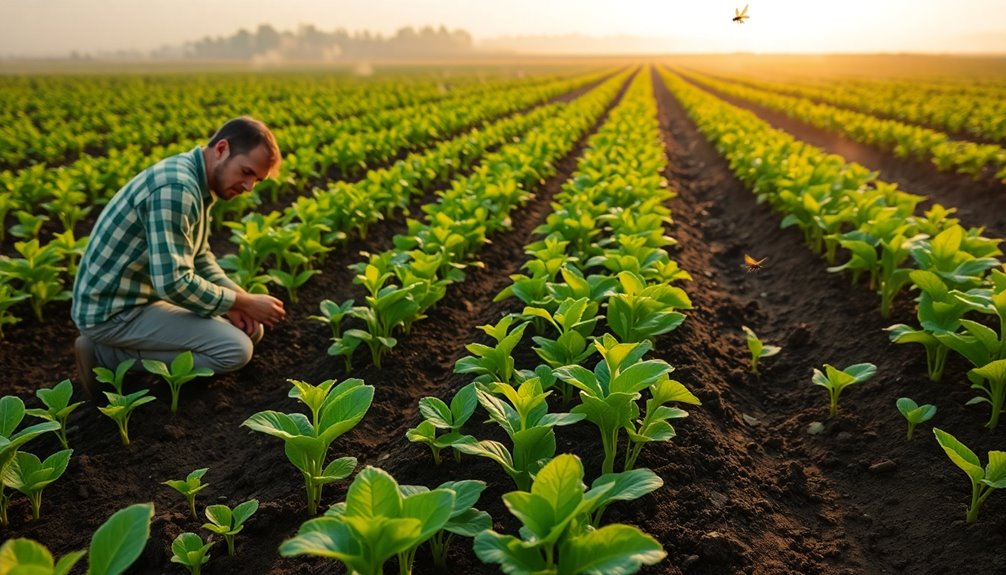
Implementing effective pest management techniques is essential for establishing healthy forage crops. Regular monitoring of pest populations allows you to intervene promptly, especially against threats like the potato leafhopper that impacts legume forages such as alfalfa.
By establishing economic thresholds for pests, you can make informed decisions, applying control measures only when necessary to minimize costs and environmental impact.
Utilizing integrated pest management (IPM) strategies is key. These approaches combine cultural practices, biological controls, and targeted pesticide applications, enhancing pest control effectiveness while reducing chemical reliance.
Early detection and rapid response to infestations can prevent considerable damage, safeguarding your yield potential and overall crop health during establishment.
Additionally, selecting pest-resistant forage species or varieties can considerably reduce the risk of infestations. This choice not only improves your crop's resilience but also contributes to more sustainable forage crop management.
Prioritizing these pest management techniques positions you for successful forage crop establishment, ensuring you cultivate healthy, productive fields for the long term.
Best Practices for Seedlings

Establishing healthy forage seedlings requires attention to several best practices that can greatly impact their growth and resilience.
By focusing on these strategies, you can guarantee a successful start for your crops and set the stage for a robust management system.
- Monitor soil moisture: Keep an eye on moisture levels to support young seedlings in their early stages.
- Implement weed management: Prevent weed competition by using effective strategies, allowing forage crops to thrive without resource constraints.
- Align fertilization with soil needs: Test soil nutrient levels and fertilize accordingly at seeding to promote ideal growth.
- Regularly check for pests: Stay vigilant, especially with legumes like alfalfa, to catch any pest issues early and maintain seedling vigor.
- Plan for early prevention: Address potential issues like weeds and pests proactively to minimize costs and labor during establishment.
Harvesting Forage Crops
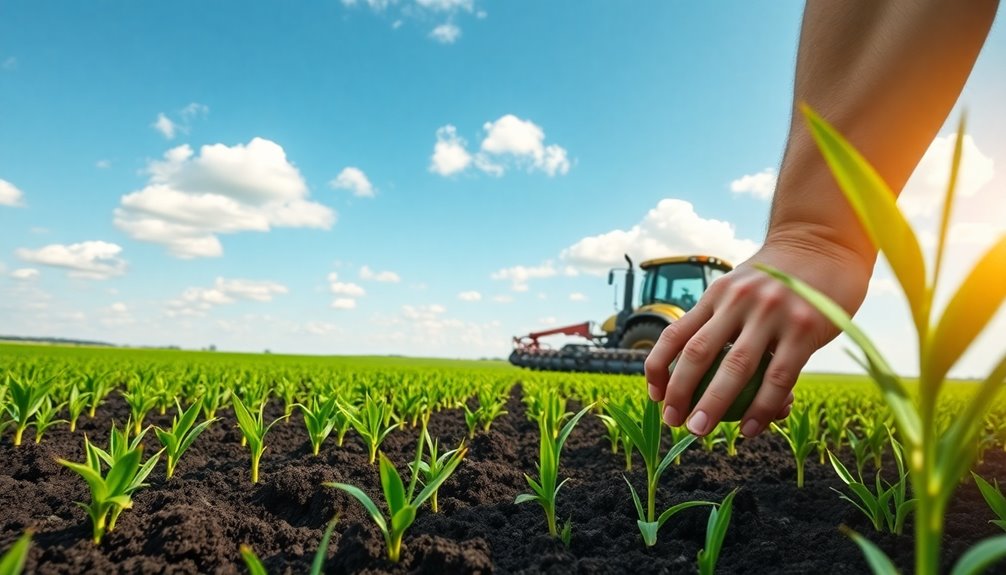
When it comes to harvesting forage crops, you'll want to use mechanical methods like dry hay, silage, and baleage that suit your livestock's needs.
Evaluating the quality of your harvested feed is essential, as factors like moisture content and maturity at harvest play a big role in nutrition.
Mechanical Harvesting Methods
Mechanical harvesting methods play an essential role in efficiently managing forage crops, ensuring ideal quality and yield. By employing the right techniques, you can maximize the potential of your forage seedings.
Different methods, like dry hay production, silage, and baleage, each require specific equipment and management practices.
- Dry hay production can yield up to 7-8 tons per acre when legume forages, such as alfalfa, are cut frequently.
- Silage involves chopping forage crops and fermenting them in anaerobic conditions, which is particularly beneficial for dairy farms.
- Round bale silage offers convenient storage but needs careful moisture management and wrapping to maintain quality.
- Baleage combines elements of hay and silage, providing a flexible option for various conditions.
- Quality assessment is vital for harvested forage, factoring in wrapping, moisture content, maturity at harvest, and density.
Quality Assessment Techniques
Effective quality assessment techniques are vital for guaranteeing that harvested forage crops meet the nutritional needs of livestock. Start by measuring the moisture content; for silage, aim for an ideal range of 60-70%. This facilitates proper fermentation and minimizes spoilage risk during storage.
Regularly sampling your forage stand is essential. By testing for protein levels and fiber content, you can confirm that the nutrient content is adequate for your livestock's health.
Next, assess the maturity stage of your forage at harvest. For legumes like alfalfa, the best quality comes from cutting at the bud to early bloom stage. This timing maximizes nutrient content and overall feed value.
Additionally, pay attention to the density of the forage. A denser stand often indicates better quality and higher yields.
Finally, when wrapping and sealing your silage, manage moisture carefully. Efficient wrapping can prevent aerobic spoilage and maintain feed quality long-term.
Grazing Management Tips
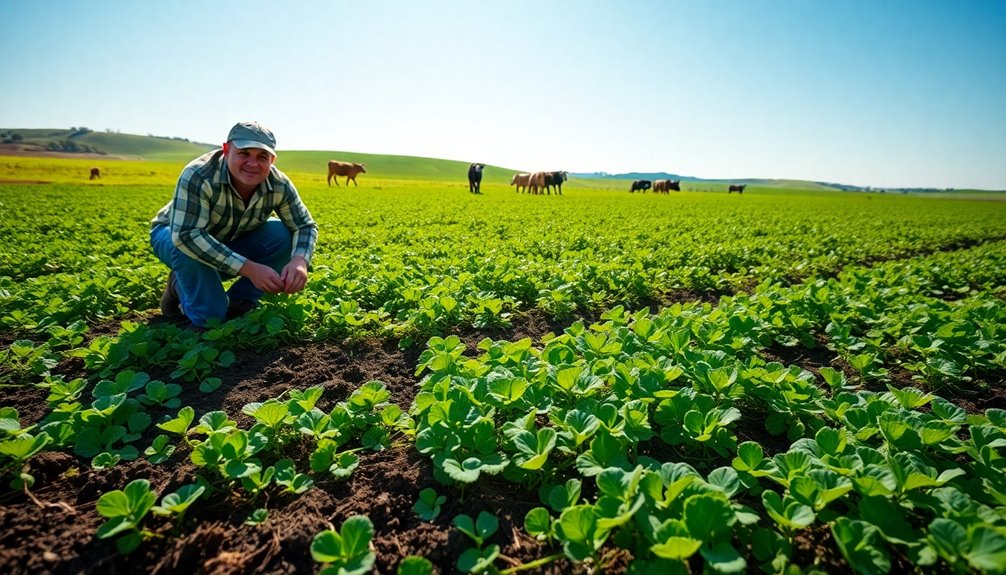
Grazing management plays an essential role in maintaining healthy pastures and maximizing forage productivity. By implementing a well-designed grazing system, you can enhance forage utilization and allow your pastures to recover, ensuring consistent feed for your livestock.
Here are some key tips to reflect upon:
- Regularly monitor soil moisture and pasture conditions to prevent soil compaction and protect your pastures' health.
- Avoid grazing too low during late summer and early fall; this can damage your forage stands and hinder future growth.
- Utilize brassica crops as a supplement to extend the grazing season, giving you additional forage options when grass growth slows.
- Regularly assess pasture conditions and adjust grazing pressure accordingly to maintain ideal forage productivity.
- Implement rotational grazing to control weeds and allow pastures to rest and regenerate effectively.
Drought Management Strategies
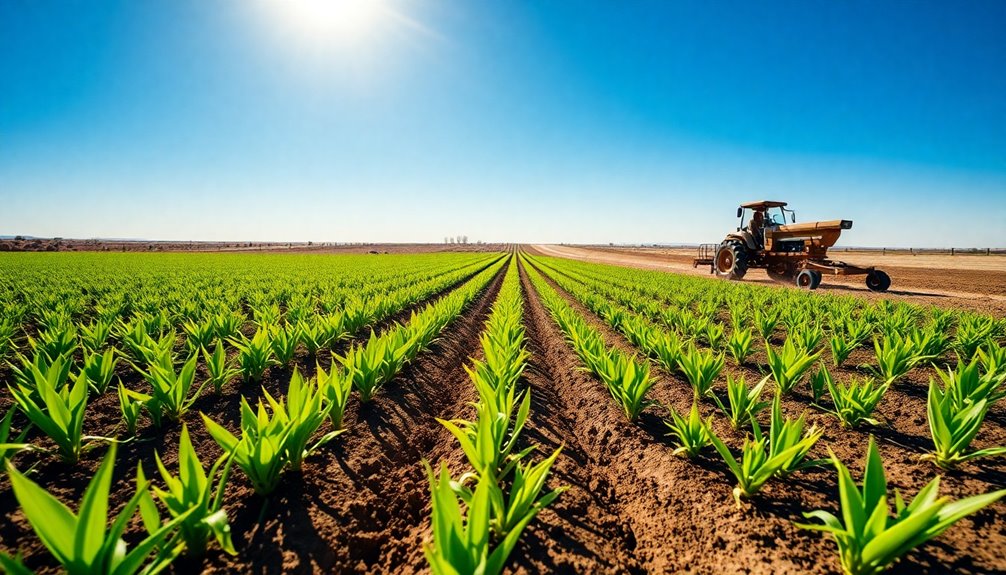
Drought can turn lush pastures into barren landscapes, making it essential to have solid management strategies in place. To sustain forage availability and livestock health during dry spells, you'll want to assess your available forage regularly. This inventory helps you understand how drought impacts your feed supplies and plan alternative feeding strategies when necessary.
Incorporating drought-resistant forage species into your planting rotation enhances resilience, ensuring productivity even in low-moisture conditions. You should also consider utilizing cover crops; they improve soil moisture retention, providing a buffer against drought's harsh effects.
Minimal tillage practices further support soil health, allowing more moisture to be retained in the ground.
Don't forget to monitor weather forecasts and soil conditions closely. This information is invaluable for making timely decisions regarding irrigation and forage management.
For instance, targeted nitrogen application can boost the growth of drought-resistant species, giving you an edge when conditions are less than ideal. By implementing these strategies, you'll be better equipped to navigate the challenges that come with drought, safeguarding your forage crops and livestock.
Frequently Asked Questions
What Is Forage Farming?
Forage farming is all about cultivating plants specifically for animal feed, like grasses and legumes.
You're aiming to create a reliable source of nutrition for your livestock, enhancing their health and productivity.
By choosing the right species based on your soil type and climate, you can optimize growth and yield.
Plus, good forage farming practices improve soil health, reducing erosion and boosting organic matter, ultimately supporting sustainable farming efforts.
Which Crop Seeding Method Is Especially Associated With Forage Crops?
Did you know that no-till seeding can increase forage crop yields by up to 30%?
This method's especially beneficial for establishing forage crops, as it reduces soil disturbance and enhances soil structure.
By sowing in late summer, you take advantage of ideal moisture and temperature for germination.
Remember, keeping the seeding depth at no more than 3/8 inches is key for proper seed-to-soil contact.
It's a game-changer for successful establishment!
What Are Forage Crops Used to Achieve?
Forage crops help you achieve multiple goals on your farm. They provide high-quality feed for your livestock, boosting their health and productivity.
By incorporating legumes like alfalfa, you enrich soil nitrogen levels, benefiting future crops. You can also reduce soil erosion and improve water retention, promoting better nutrient cycling.
Plus, they extend the grazing season, optimize pasture use, and enhance sustainability, making your farming operations more efficient and productive.
What Factors Do You Need to Consider for the Quality of Forage Crops?
Think of your forage crops like a fine wine; the right conditions make all the difference.
To guarantee quality, you need to take into account soil type, pH, and nutrient levels.
Just like a wine's flavor depends on its grapes, your forage's success hinges on proper weed control and moisture management.
Regular soil testing every few years helps you tailor your approach, guaranteeing your crops thrive and deliver the best yield possible.
Conclusion
Establishing forage crops isn't just about planting seeds; it's a delicate dance between preparation and timing. While you might rush into sowing, remember that thoughtful planning yields healthier, more productive pastures. In contrast, neglecting soil health can turn your efforts into a struggle against weeds and drought. By embracing best practices and proactive management, you'll transform your fields from mere patches of grass to thriving ecosystems that support both livestock and sustainable farming.

